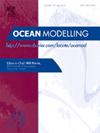从底部地形再看潮汐整流
IF 2.9
3区 地球科学
Q2 METEOROLOGY & ATMOSPHERIC SCIENCES
引用次数: 0
摘要
潮汐整流在控制沿海地区平均输运和海岸-盆地物质交换中起着关键作用。为了计算平均流量,传统的方法需要高分辨率的流域尺度数值模拟,这需要大量的计算资源。本文重新研究了地形变化和海底摩擦对潮汐整流的影响,并提出了一种新的解析解。第一步是在尽可能简单的配置中推导解。因此,我们重新审视一维(1D)构型的解决方案,使用拉格朗日方法,从欧拉结果推导。给出了无摩擦情况下的精确解,并给出了更为实际的二次底摩擦情况下的近似解。然后通过数值模型分析了粘度对溶液的影响。当考虑二次底摩擦时,后者的影响较小。然而,当稳定整流电流延伸到超过临界深度的区域时,粘度会导致虚假效应并改变数值结果的准确性。结果表明,临界深度可以表示为摩擦系数、潮汐通量和地形变化长度尺度的函数。最后,我们将一维情况下的解析解扩展到二维(2D)情况。将二维解与海洋环流模型在复杂地形和二次底摩擦条件下求解全正压方程的结果进行了比较。解析解与数值模拟结果的比较表明,稳态整流潮流的大小和方向符合较好。对底摩擦和潮汐幅值的敏感性试验表明,稳定整流电流平行于等深线,与一阶底摩擦系数的大小无关。本文章由计算机程序翻译,如有差异,请以英文原文为准。
Revisiting tidal rectification by bottom topography
Tidal rectification plays a key role in controlling mean transport in coastal areas and coast-basin material exchange. To calculate mean flows, conventional approaches require high-resolution basin-scale numerical simulations which demands substantial computational resources. This study revisits tidal rectification governed by topographic variation and bottom friction, and proposes a new analytical solution.
The first step is to derive solutions in the simplest possible configuration. We thus revisit solutions in one-dimensional (1D) configurations, using a Lagrangian approach from which Eulerian results are derived. Exact solutions are provided for the frictionless case and new approximate solutions are developed for a more realistic quadratic bottom friction.
We then analyze the influence of viscosity on solutions from numerical models. We find that the latter has moderate influence when quadratic bottom friction is considered. However, when the steady rectified current extends over regions deeper than a critical depth, viscosity can lead to spurious effects and alter the accuracy of the numerical results. We show the critical depth can be expressed as a function of friction coefficient, tidal flux and topography variation length-scale.
We finally extend the analytical solutions derived for the 1D case to the two-dimensional (2D) case. The 2D solutions are compared to results from an ocean general circulation model solving the full barotropic equations in an academic configuration with a complex topography and a quadratic bottom friction. Comparison between analytical solutions and numerical simulations shows good agreement for both the magnitude and direction of the steady rectified tidal current. Sensitivity tests to bottom friction and tide amplitude show that the steady rectified current is parallel to the isobaths and independent of the magnitude of the bottom friction coefficient at first order.
求助全文
通过发布文献求助,成功后即可免费获取论文全文。
去求助
来源期刊

Ocean Modelling
地学-海洋学
CiteScore
5.50
自引率
9.40%
发文量
86
审稿时长
19.6 weeks
期刊介绍:
The main objective of Ocean Modelling is to provide rapid communication between those interested in ocean modelling, whether through direct observation, or through analytical, numerical or laboratory models, and including interactions between physical and biogeochemical or biological phenomena. Because of the intimate links between ocean and atmosphere, involvement of scientists interested in influences of either medium on the other is welcome. The journal has a wide scope and includes ocean-atmosphere interaction in various forms as well as pure ocean results. In addition to primary peer-reviewed papers, the journal provides review papers, preliminary communications, and discussions.
 求助内容:
求助内容: 应助结果提醒方式:
应助结果提醒方式:


